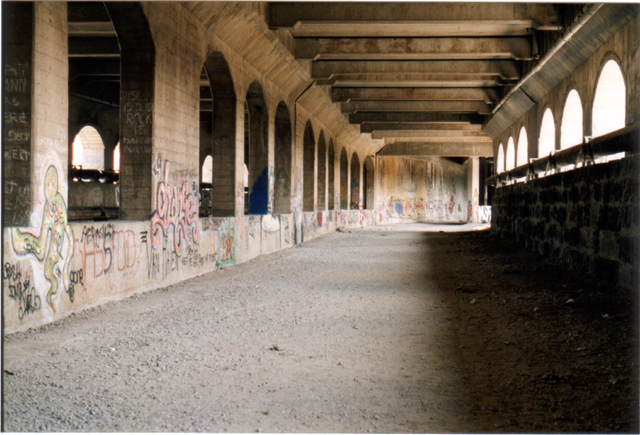|
Genesee Vignettes
Personal Reflections on the Genesee River
A series of eighteen essays by
IV. The Erie Canal
V. The University of Rochester
IV. The Erie Canal
In the heart of downtown Rochester, several east-west streets cross the
river in quick succession. From north to south these are Andrews Street,
Main Street, Broad Street, and Court Street. In addition, just upstream
from the Court Street bridge is the I-490 bridge and just downstream from
the Andrews Street Bridge is the bridge that carries an expressway—known
as "the Inner Loop"—around the city center. Thus has Rochester's
downtown been woven together for the benefit of automobile traffic.
Yet the transportation revolution that catapulted a small frontier community
into an industrial boomtown hadn't featured automobiles. Nor had it featured
railroads. Instead, Rochester became a city as a result of canals.
American canal building began on a modest scale during the years following
the War for Independence. But these earliest canals were only a few miles
in length. By contrast, the scale of the Erie Canal—whose construction
was authorized by New York State in 1817—was unprecedented. From
the outset it was intended to stretch, east to west, nearly 365 miles.
The stakes for the enterprise had little specifically to do with Rochester.
Instead, the canal's main purpose was to tie New York City—which
was itself tied to the markets of the world—with the resources of
the continental interior. Nevertheless, when the canal opened in 1825,
Rochester found itself occupying a privileged position on the new trunk
line.
When I moved to Rochester in August 1992, the apartment I rented in suburban
Brighton was just a five-minute drive from the Barge Canal and its towpath
hiking trail. But I soon learned that the Barge Canal was an early twentieth-century
reworking of the original Erie Canal. Where the Barge Canal now follows
a route well south of the city center, the old Erie Canal had gone right
downtown. For a short distance, it had paralleled the river.Then it had
turned due west and crossed the river on a stone aqueduct.
The very first aqueduct was rebuilt in the early 1840s, and that rebuilt
structure still stands—with the Broad Street automobile bridge running
atop it. Early in the twentieth century, a trolley line crossed the river
on the dry aqueduct bed. Those tracks are gone now, and periodically I
read about possible alternative uses for the space. But when I visited
it on 1 September 1986, it was little more than a gallery of graffiti
art:


V. The University of Rochester
On my interview trip in early June 1982 I had flown to Rochester and
followed the schedule set by RIT's History Department. Not until after
taking the job (and then buying my first car) had I driven up, for a visit
more on my own terms. The main reason for the second trip was to locate
a suitable apartment. My plan was to spend a few days in Scottsville,
New York, with Glenn Kist—one of my new history colleagues—and
before leaving Baltimore, I let him know when to expect me. The highway
drive left no memories. But I still recall my first stop in Rochester.
I had deliberately arrived well ahead of the appointed time, because I
wanted to swing by the University of Rochester and visit its library.
Although I had been a graduate student at Johns Hopkins for five years,
I was still very much in the middle of writing my dissertation. My topic
was the early career of Merle A. Tuve, an American physicist who helped
transform the Van de Graaff generator into one of the earliest particle
accelerators, for use in the new field of nuclear physics. During the
1930s, Tuve and his associates at one of the Carnegie Institution of Washington’s
research labs studied how the repulsive electrical forces between protons
were replaced by strong forces of attraction in the nucleus. Thus Tuve’s
project—involving large, complex, expensive equipment run by a team
of researchers in an organized setting—was a precursor of what was
later called “Big Science.”*
In pursuing that work, I had grown accustomed to having access to large
libraries—not just the Milton S. Eisenhower Library at Johns Hopkins,
but also the Library of Congress. I knew from my interview trip that the
RIT library was not well suited for completing my dissertation. Day trips
to Cornell University and occasional return visits to the Baltimore-Washington
area were definite possibilities. Short of that, however, I wondered it
I'd be able to continue my work at the U. of R. library. Did it have long
runs of the journals I had been using, and did it have shelf after shelf
of books on topics relevant to my research?
Such were the questions I had on my mind as I parked on Wilson Boulevard
and walked the length of the quad to the main doors of Rush Rhees Library.
Within about forty minutes, the answers were clear: I was in business!
That fall I was too preoccupied with course preparations to do any research.
But in subsequent quarters I was able to find occasional blocks of time—a
few hours, here and there—and in driving from RIT along East River
Road I would feel the same eager anticipation I had felt when approaching
the Hopkins library: what new material am I going to discover today?
In the process I learned that the U. of R. had not always been located
at its current site. Originally it had been located much closer to downtown,
and its old campus can still be seen around the Memorial Art Gallery.
But a bequest from George Eastman in 1932 enabled the University to build
from scratch an entirely new campus—called the River Campus—between
Mount Hope Cemetery and the Genesee River.
The topography turns out to be important. Prior to the most recent Ice
Age, the ancestral Genesee had interrupted its northward flow well south
of Rochester, jogged eastward several miles, and then headed northward
again—through what is now Irondequoit Bay. As the ice retreated,
however, the water draining off its slopes left huge deposits that reshaped
the local terrain, first at Mendon Ponds Park and then at the Pinnacle
Hills. As the ice retreated still further, the Genesee opted for a new
stream bed. With its old eastward jog now blocked, it skirted the Pinnacle
Hills along their western flank—which is the terrain now occupied
by the River Campus.
Like a fort protecting the flow of goods up and down a literal river,
the U. of R. stands on high ground protecting commerce of a more figurative
sort. Although people have been creating new knowledge for centuries,
the organized production of new knowledge is a relatively recent
development. Up until the nineteenth century the spring of human creativity
fed streams that were rarely navigable. Indeed, so low was the volume
of new-knowledge creation that few cultural goods could be floated—much
less transported dependably or regularly over long distances.
But by the late nineteenth century, a trend toward organized research
visibly increased the volume of new-knowledge creation—to such an
extent that the modest streams of the past were transformed into broad
rivers. For the first time it became possible to convey all sorts of cultural
goods along these expanded waterways: new feats of engineering, industries
that were genuinely science-based, and what became known as "scientific
medicine."
At Hopkins I had found myself near the mouth of one of the world's major
rivers of research, and in leaving the Baltimore-Washington area, I feared
I was absenting myself to a research backwater. But slowly I realized
that my new surroundings lay in the same watershed. More than that, I
was still on the mainstream—though, of course, further upriver from
where I had been as a grad student.
As I learned more about the U. of R., I realized it was a relative newcomer
to "the Research Revolution"—which is the label my dissertation
advisor, Robert Kargon, had used for the rapid rise of research organizations.
Although the U. of R. had been established in 1850, not until the years
between the World Wars was it transformed from an undergraduate college
with a strictly local reputation to a nationally and internationally recognized
research university.
I also learned that the city of Rochester owes its position on the research
mainstream to far more than just the U. of R. Going back to the mid-nineteenth
century, Henry A. Ward made a business of supplying natural history specimens
to colleges and universities across the country. Just after the turn of
the century, George Eastman hired an English chemist, C. E. Kenneth Mees,
and placed him at the head of one of the world's first industrial research
laboratories. Meanwhile, the Bausch and Lomb Company manufactured thousands
upon thousands of microscopes—totaling a quarter million by 1930.
In short, Rochester may have been established as an industrial city in
the era of canals and water power, but it also succeeded in keeping pace
with the rapid changes of the big-business era—including the shift
from tradition-based knowledge to research-based knowledge.
In the process, RIT—my place of employment—was likewise transformed.
It had emerged in the nineteenth century as an "athenaeum" (to
provide the public with suitable cultural activities) and as a "mechanics
institute" (to provide students with a practical alternative to high
school). Not until after World War II did it begin offering four-year,
accredited baccalaureates. Gradually, it also added a variety of master's
programs, and a few years ago it established its first Ph.D. program (in
imaging science). Older faculty still recall how research was not an expectation
when they were hired. Even now, teaching remains primary. Yet alongside
teaching, research has also come to "count," and the Ph.D. degree
is a requirement for most new hires.
* For a brief published account, see Thomas D. Cornell, “Merle
Antony Tuve:
Pioneer Nuclear Physicist,” Physics Today, 41 (Jan. 1988),
57-64.
Photos by author.
© 2005, Thomas D. Cornell
|



